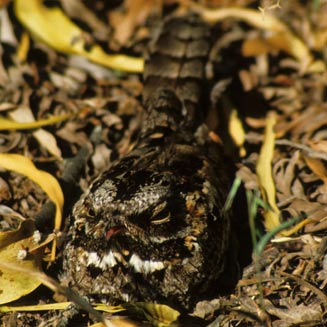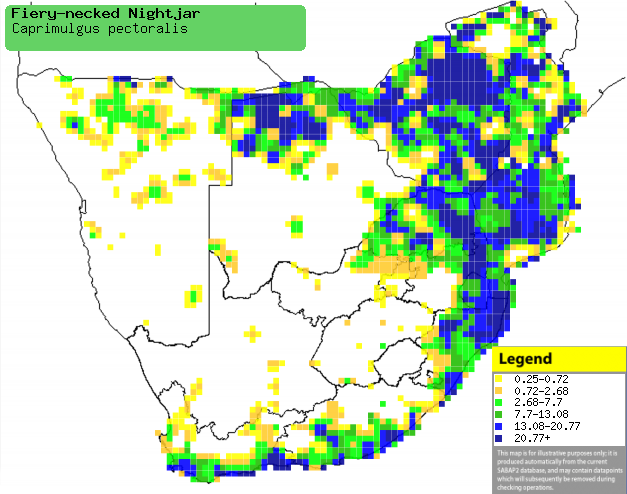|
Caprimulgus pectoralis
(Fiery-necked nightjar)
Afrikaanse naguil [Afrikaans]; Udebeza [Xhosa]; uZavolo
(also applied to European nightjar) [Zulu]; Rumbamba (generic term for nightjar)
[Kwangali]; Leuwauwe [North Sotho]; Datiwa (generic name for nightjar) [Shona];
Malwelwe (generic term for nightjar) [Swazi]; Kubhasti (generic term for
nightjar) [Tsonga]; Leubauba, Mmapheke, Tshogwi (all 3 are generic terms for
nightjar) [Tswana]; Roesthalsnachtzwaluw [Dutch]; Engoulevent musicien [French];
Rotnacken-nachtschwalbe [German]; Noitibó-de-pescoço-dourado [Portuguese]
Life
> Eukaryotes >
Opisthokonta
> Metazoa (animals) >
Bilateria >
Deuterostomia > Chordata >
Craniata > Vertebrata (vertebrates) > Gnathostomata (jawed
vertebrates) > Teleostomi (teleost fish) > Osteichthyes (bony fish) > Class:
Sarcopterygii (lobe-finned
fish) > Stegocephalia (terrestrial
vertebrates) > Tetrapoda
(four-legged vertebrates) > Reptiliomorpha > Amniota >
Reptilia (reptiles) >
Romeriida > Diapsida > Archosauromorpha > Archosauria >
Dinosauria
(dinosaurs) > Saurischia > Theropoda (bipedal predatory dinosaurs) >
Coelurosauria > Maniraptora > Aves
(birds) > Order: Strigiformes > Family: Caprimulgidae
 |
 |
|
Fiery-necked nightjar. [photos Peter Steyn
©] |
The Fiery-necked nightjar occupies a large area of Africa
south of the equator, avoiding extremely arid areas, mainly occurring in
well-developed woodland with dense leaf litter. It is insectivorous, feeding
mainly on beetles and moths, usually hunting at dawn or dusk. The nest is a
simple depression in the ground, usually in and surrounded by leaf litter. Here
it usually lays 2 eggs, which are incubated by both sexes for about 18-19 days.
The chicks are cared for by both parents, and can fly strongly at about 17-18
days old. The parents usually desert their territory and chicks when they reach
30 days old, however the brood still live there for up to 150 days more before
leaving.
Distribution and habitat
Occurs from Tanzania, southern DRC and Angola to southern Africa,
where it is common and widespread in northern Namibia, northern and eastern
Botswana, Zimbabwe, Mozambique and eastern and southern South Africa. It
generally prefers well-developed woodland
with dense leaf litter for nesting and roosting, such as Acacia, miombo (Brachystegia)
and broad leaved woodland, also moving into plantations and gardens.
|
 |
|
Distribution of Fiery-necked nightjar in southern Africa,
based on statistical smoothing of the records from first SA Bird Atlas
Project (©
Animal Demography unit, University of
Cape Town; smoothing by Birgit Erni and Francesca Little). Colours range
from dark blue (most common) through to yellow (least common).
See here for the latest distribution
from the SABAP2. |
Predators and parasites
- Predators
-
Genetta (genets)
- domestic dogs
- humans
Food
Insectivorous, with most of
its diet made up of beetles and moths. It usually forages at dusk, before dawn
or in the middle of the night, as long as the moon is full enough to provide a
bit of light. Most of hunting is done from perch on a tree branch, stump or fencepost,
making repeated forays out into the night, catching an insect before returning
to its perch to feed. The following food items have been recorded in its diet:
Breeding
- Monogamous, solitary nester, with breeding
pairs staying together their whole lives.
- The nest is a simple depression in the ground, usually in and surrounded
by dense leaf litter.
- It typically lays two eggs, which are incubated by both sexes for about
18-19 days; the female incubates in the day, while the male
takes the night shift. If the eggs are destroyed or fail to hatch, the
female often lays a replacement clutch.
- The chicks are cared for by both parents, who perform elaborate
distraction displays if disturbed from the nest, to try an lure predators
away from the brood. The chicks start walking around at about eight days old,
taking their first, weak flight at about 14 days old, and can fly strongly
about 5-7 days later. The parents usually desert their territory and chicks
when they reach 30 days old, however the brood only leave the territory
approximately five months later.
Threats
Not threatened, in fact common and widespread, however its
populations in Zambia and Zimbabwe have been badly affected by habitat
destruction.
References
-
Hockey PAR, Dean WRJ and Ryan PG (eds) 2005. Roberts
- Birds of southern Africa, VIIth ed. The Trustees of the John Voelcker
Bird Book Fund, Cape Town.
|
